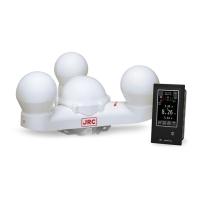5-3 Chapter 5 Installation Method
5
5.2 Installation of the GPS Compass Sensor
When installing the cable that is attached to the GPS compass sensor, do
not bend the cable to a sharp angle, twist it, or install it in such a manner
that some force is applied to the cable.
Failure to comply may cause cracks or damage inside of the film, resulting
in fire or an electric shock.
Do not install the GPS compass sensor in a place that is exposed to severe
vibration.
Failure to comply may cause reception defects, resulting in an accident.
This equipment determines the ship’s heading azimuth by using carrier waves of the GPS satellite.
Install the GPS compass sensor in a place free from any barriers so that the sensor can directly receive
radio waves from the satellite without any blockage or re-reflection of waves in the surrounding
environment. An unsuitable sensor installation environment may cause frequent interruptions of the
ship’s heading azimuth calculation.
If an ideal location cannot be selected easily and some compromise is necessary, initially install the
GPS compass sensor and fix the sensor after carrying out tests as to whether specified performance
can be obtained. Installation of the GPS compass sensor in an unsuitable place causes deterioration of
accuracy, resulting in possible accidents. Under low visibility or frequent radio reflections, deterioration
of azimuth accuracy or interruption of azimuth measurements may occur.
Install the GPS compass sensor in the place that complies with the following criteria.

